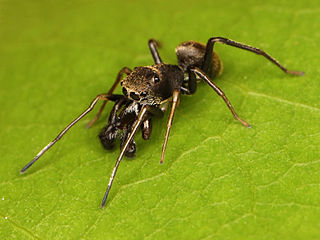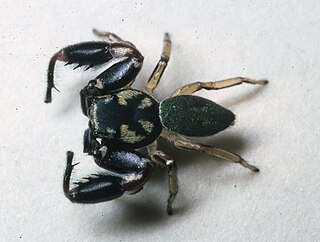
Balmaceda is a genus of jumping spiders that was first described by George Peckham & Elizabeth Peckham in 1894..

Breda is a genus of jumping spiders that was first described by George Peckham & Elizabeth Peckham in 1894.

Chira is a genus of jumping spiders that was first described by George Peckham & Elizabeth Peckham in 1896. It is currently named after Rio Chira, a river in Peru, but the Peckhams originally called the genus Shira, later emended by Eugène Simon.
Chirothecia is a genus of jumping spiders that was first described by Władysław Taczanowski in 1878. Chirothecia is very similar to Bellota, but can be distinguished by the following characteristics: a much wider and taller cephalothorax ; a much longer eye area ; the posterior median eyes are always closer to the anterior lateral eyes than the posterior lateral eyes.

Cotinusa is a genus of jumping spiders that was first described by Eugène Louis Simon in 1900.
Descanso is a genus of jumping spiders that was first described by George and Elizabeth Peckham in 1892. The name is derived from Spanish descanso, meaning "resting place ", from the verb descansar "to rest."

Euophrys is a genus of jumping spiders that was first described by Carl Ludwig Koch in 1834. The small black E. omnisuperstes lives on Mount Everest at elevations up to 6,700 meters, possibly making it the most elevated animal in the world.
Eustiromastix is a genus of jumping spiders that was first described by Eugène Louis Simon in 1902.
Fluda is a genus of jumping spiders that was first described by George and Elizabeth Peckham in 1892.

Frigga is a genus of jumping spiders that was first described by Carl Ludwig Koch in 1850. The name is derived from Frigga, a Norse goddess.

Jollas is a genus of jumping spiders (Salticidae), found in Central America, the Caribbean and South America.

Lyssomanes is a spider genus of the family Salticidae, ranging from South and Central America, up to the southern United States.

Marpissa is a genus of jumping spiders that was first described by Carl Ludwig Koch in 1846. The name is derived from Marpissa, an ancient Greek village.

Martella is a genus of ant mimicking jumping spiders that was first described by George and Elizabeth Peckham in 1892. Species of this genus are found in South America and Central America.

Metaphidippus is a genus of jumping spiders that was first described by Frederick Octavius Pickard-Cambridge in 1901. The name is combined from Ancient Greek μετά "after, beside" and the salticid genus Phidippus.

Pachomius is a genus of jumping spiders that was first described by George and Elizabeth Peckham in 1896. Uspachia was merged into genus Romitia in 2007, and all nine species were merged into Pachomius in 2015. The name is derived from Pachomius, the founder of cenobitic monasticism.

Rudra is a genus of jumping spiders that was first described by George and Elizabeth Peckham in 1885. The name refers to Rudra, a Rigvedic god.

Sarinda is a genus of ant mimicking jumping spiders that was first described by George and Elizabeth Peckham in 1892.

Synemosyna is a genus of ant mimicking jumping spiders that was first described by Nicholas Marcellus Hentz in 1846.

The Dendryphantina are a subtribe of jumping spiders that occur mainly in the New World. The subtribe was first defined by Anton Menge in 1879 as Dendryphantidae. Females of the subtribe generally show paired spots on the abdomen, and the males often have enlarged chelicerae. Females in this subtribe typically have S-shaped epigynal openings.
















